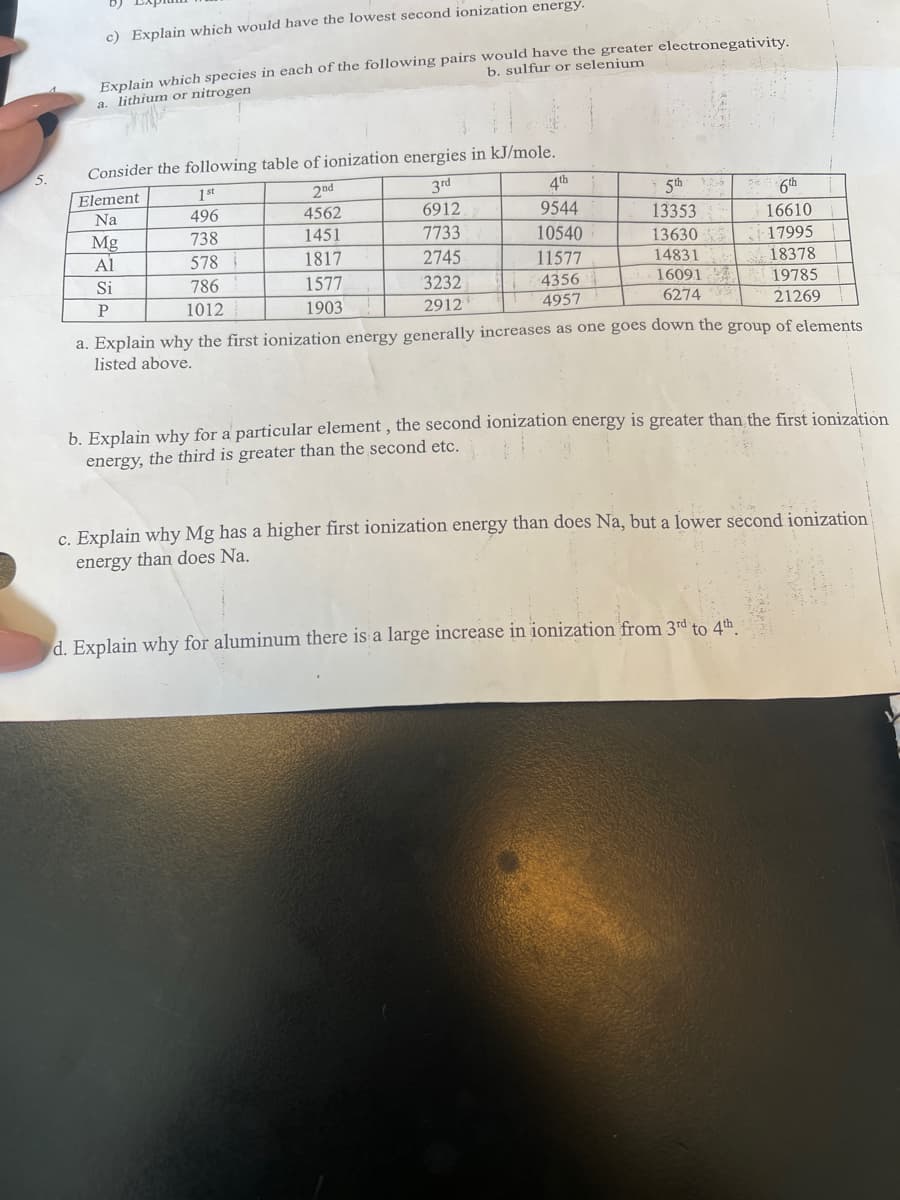Consider the following table of ionization energies in kJ/mole. 2nd 3rd 4th Element Na 1 st 496 5th 13353 6th 4562 6912 9544 16610 Mg 738 1451 7733 10540 13630 17995 18378 Al 578 1817 2745 11577 14831 Si 786 1577 3232 4356 16091 19785 1012 1903 2912 4957 6274 21269 a. Explain why the first ionization energy generally increases as one goes down the group of elements listed above. b. Explain why for a particular element, the second ionization energy is greater than the first ionizatior energy, the third is greater than the second etc. c. Explain why Mg has a higher first ionization energy than does Na, but a lower second ionization energy than does Na. d. Explain why for aluminum there is a large increase in ionization from 3rd to 4th
Consider the following table of ionization energies in kJ/mole. 2nd 3rd 4th Element Na 1 st 496 5th 13353 6th 4562 6912 9544 16610 Mg 738 1451 7733 10540 13630 17995 18378 Al 578 1817 2745 11577 14831 Si 786 1577 3232 4356 16091 19785 1012 1903 2912 4957 6274 21269 a. Explain why the first ionization energy generally increases as one goes down the group of elements listed above. b. Explain why for a particular element, the second ionization energy is greater than the first ionizatior energy, the third is greater than the second etc. c. Explain why Mg has a higher first ionization energy than does Na, but a lower second ionization energy than does Na. d. Explain why for aluminum there is a large increase in ionization from 3rd to 4th
Chapter8: Bonding: General Concepts
Section: Chapter Questions
Problem 152CP: Think of forming an ionic compound as three steps (this is a simplification, as with all models):...
Related questions
Question

Transcribed Image Text:c) Explain which would have the lowest second ionization energy.
Explain which species in each of the following pairs would have the greater electronegativity.
a. lithium or nitrogen
b. sulfur or selenium
Consider the following table of ionization energies in kJ/mole.
Element
1st
2nd
3rd
4th
5th
6th
Na
496
4562
6912
9544
13353
16610
738
1451
7733
Mg
Al
10540
13630
17995
18378
578
1817
2745
11577
14831
Si
786
1577
3232
4356
16091
19785
P
1012
1903
2912
4957
6274
21269
a. Explain why the first ionization energy generally increases as one goes down the group of elements
listed above.
b. Explain why for a particular element , the second ionization energy is greater than the first jonization
energy, the third is greater than the second etc.
c. Explain why Mg has a higher first ionization energy than does Na, but a lower second ionization
energy than does Na.
d. Explain why for aluminum there is a large increase in ionization from 3rd to 4th
Expert Solution
This question has been solved!
Explore an expertly crafted, step-by-step solution for a thorough understanding of key concepts.
This is a popular solution!
Trending now
This is a popular solution!
Step by step
Solved in 2 steps

Knowledge Booster
Learn more about
Need a deep-dive on the concept behind this application? Look no further. Learn more about this topic, chemistry and related others by exploring similar questions and additional content below.Recommended textbooks for you


Chemistry: An Atoms First Approach
Chemistry
ISBN:
9781305079243
Author:
Steven S. Zumdahl, Susan A. Zumdahl
Publisher:
Cengage Learning

Chemistry
Chemistry
ISBN:
9781305957404
Author:
Steven S. Zumdahl, Susan A. Zumdahl, Donald J. DeCoste
Publisher:
Cengage Learning


Chemistry: An Atoms First Approach
Chemistry
ISBN:
9781305079243
Author:
Steven S. Zumdahl, Susan A. Zumdahl
Publisher:
Cengage Learning

Chemistry
Chemistry
ISBN:
9781305957404
Author:
Steven S. Zumdahl, Susan A. Zumdahl, Donald J. DeCoste
Publisher:
Cengage Learning

Chemistry for Engineering Students
Chemistry
ISBN:
9781337398909
Author:
Lawrence S. Brown, Tom Holme
Publisher:
Cengage Learning

Introductory Chemistry: A Foundation
Chemistry
ISBN:
9781337399425
Author:
Steven S. Zumdahl, Donald J. DeCoste
Publisher:
Cengage Learning

Chemistry & Chemical Reactivity
Chemistry
ISBN:
9781133949640
Author:
John C. Kotz, Paul M. Treichel, John Townsend, David Treichel
Publisher:
Cengage Learning